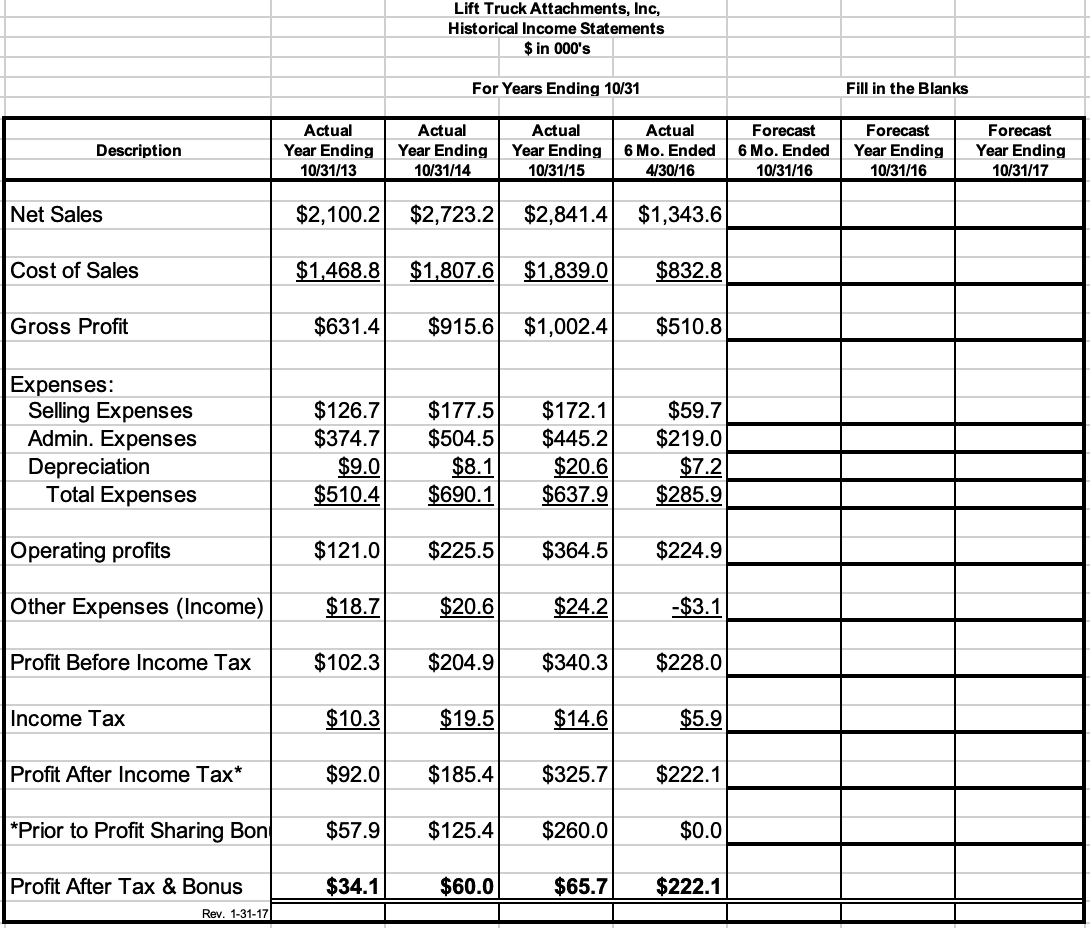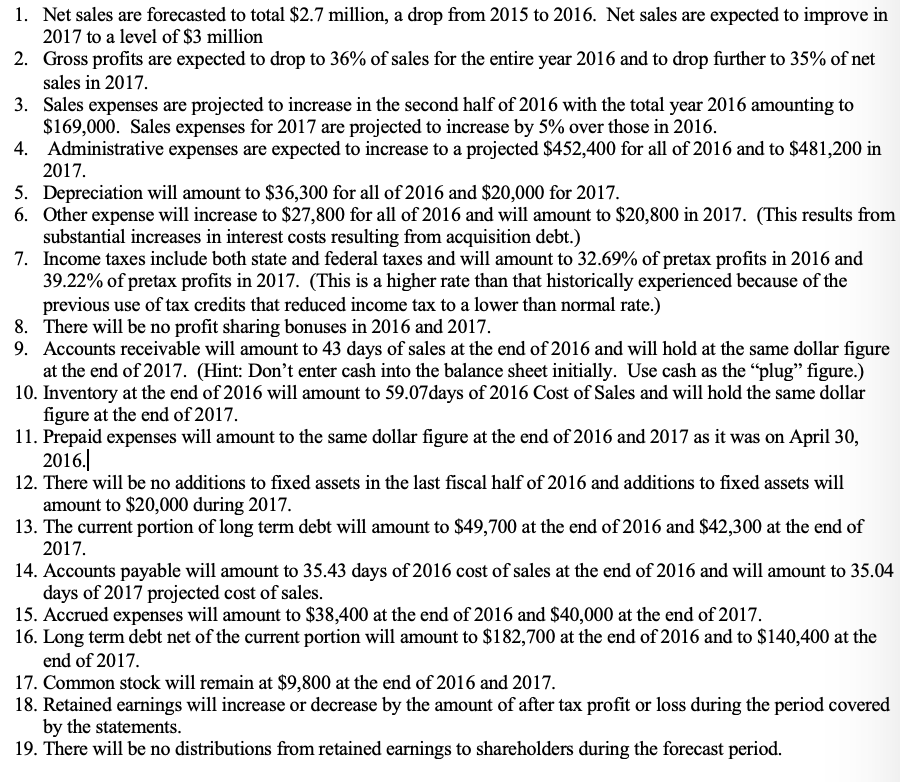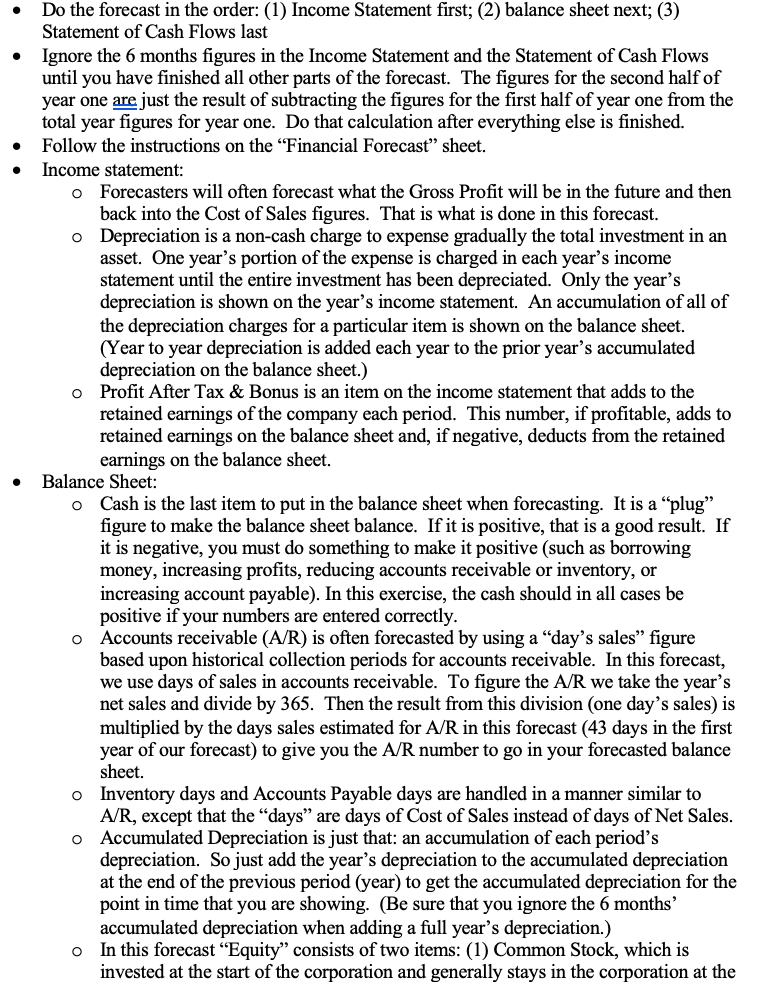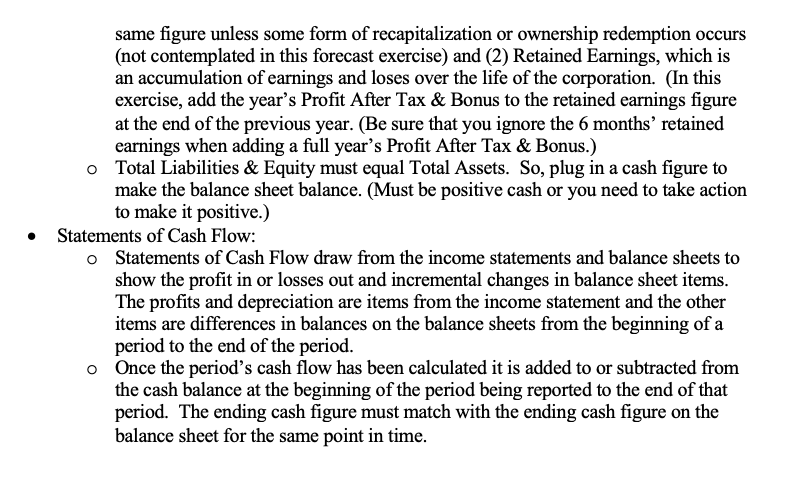Only the Income Statement



Lift Truck Attachments, Inc, Historical Income Statements $ in 000's For Years Ending 10/31 Fill in the Blanks Description Actual Year Ending 10/31/13 Actual Year Ending 10/31/14 Actual Year Ending 10/31/15 Actual 6 Mo. Ended 4/30/16 Forecast 6 Mo. Ended 10/31/16 Forecast Year Ending 10/31/16 Forecast Year Ending 10/31/17 Net Sales $2,100.2 $2,723.2 $2,841.4 $1,343.6 Cost of Sales $1,468.8 $1,807.6 $1,839.0 $832.8 Gross Profit $631.4 $915.6 $1,002.4 $510.8 Expenses: Selling Expenses Admin. Expenses Depreciation Total Expenses $126.7 $374.7 $9.0 $510.4 $177.5 $504.5 $8.1 $690.1 $172.1 $445.2 $20.6 $637.9 $59.7 $219.0 $7.2 $285.9 Operating profits $121.0 $225.5 $364.5 $224.9 Other Expenses (Income) $18.7 $20.6 $24.2 -$3.1 Profit Before Income Tax $102.3 $204.9 $340.3 $228.0 Income Tax $10.3 $19.5 $14.6 $5.9 Profit After Income Tax* $92.0 $185.4 $325.7 $222.1 *Prior to Profit Sharing Bon $57.9 $125.4 $260.0 $0.0 Profit After Tax & Bonus $34.1 $60.0 $65.7 $222.1 Rev. 1-31-17 1. Net sales are forecasted to total $2.7 million, a drop from 2015 to 2016. Net sales are expected to improve in 2017 to a level of $3 million 2. Gross profits are expected to drop to 36% of sales for the entire year 2016 and to drop further to 35% of net sales in 2017. 3. Sales expenses are projected to increase in the second half of 2016 with the total year 2016 amounting to $169,000. Sales expenses for 2017 are projected to increase by 5% over those in 2016. 4. Administrative expenses are expected to increase to a projected $452,400 for all of 2016 and to $481,200 in 2017. 5. Depreciation will amount to $36,300 for all of 2016 and $20,000 for 2017. 6. Other expense will increase to $27,800 for all of 2016 and will amount to $20,800 in 2017. (This results from substantial increases in interest costs resulting from acquisition debt.) 7. Income taxes include both state and federal taxes and will amount to 32.69% of pretax profits in 2016 and 39.22% of pretax profits in 2017. (This is a higher rate than that historically experienced because of the previous use of tax credits that reduced income tax to a lower than normal rate.) 8. There will be no profit sharing bonuses in 2016 and 2017. 9. Accounts receivable will amount to 43 days of sales at the end of 2016 and will hold at the same dollar figure at the end of 2017. (Hint: Don't enter cash into the balance sheet initially. Use cash as the plug figure.) 10. Inventory at the end of 2016 will amount to 59.07days of 2016 Cost of Sales and will hold the same dollar figure at the end of 2017. 11. Prepaid expenses will amount to the same dollar figure at the end of 2016 and 2017 as it was on April 30, 2016.) 12. There will be no additions to fixed assets in the last fiscal half of 2016 and additions to fixed assets will amount to $20,000 during 2017. 13. The current portion of long term debt will amount to $49,700 at the end of 2016 and $42,300 at the end of 2017. 14. Accounts payable will amount to 35.43 days of 2016 cost of sales at the end of 2016 and will amount to 35.04 days of 2017 projected cost of sales. 15. Accrued expenses will amount to $38,400 at the end of 2016 and $40,000 at the end of 2017. 16. Long term debt net of the current portion will amount to $182,700 at the end of 2016 and to $140,400 at the end of 2017. 17. Common stock will remain at $9,800 at the end of 2016 and 2017. 18. Retained earnings will increase or decrease by the amount of after tax profit or loss during the period covered by the statements. 19. There will be no distributions from retained earnings to shareholders during the forecast period. o Do the forecast in the order: (1) Income Statement first; (2) balance sheet next; (3) Statement of Cash Flows last Ignore the 6 months figures in the Income Statement and the Statement of Cash Flows until you have finished all other parts of the forecast. The figures for the second half of year one are just the result of subtracting the figures for the first half of year one from the total year figures for year one. Do that calculation after everything else is finished. Follow the instructions on the "Financial Forecast" sheet. Income statement: o Forecasters will often forecast what the Gross Profit will be in the future and then back into the Cost of Sales figures. That is what is done in this forecast. o Depreciation is a non-cash charge to expense gradually the total investment in an asset. One year's portion of the expense is charged in each year's income statement until the entire investment has been depreciated. Only the year's depreciation is shown on the year's income statement. An accumulation of all of the depreciation charges for a particular item is shown on the balance sheet. (Year to year depreciation is added each year to the prior year's accumulated depreciation on the balance sheet.) Profit After Tax & Bonus is an item on the income statement that adds to the retained earnings of the company each period. This number, if profitable, adds to retained earnings on the balance sheet and, if negative, deducts from the retained earnings on the balance sheet. Balance Sheet: Cash is the last item to put in the balance sheet when forecasting. It is a plug" figure to make the balance sheet balance. If it is positive, that is a good result. If it is negative, you must do something to make it positive (such as borrowing money, increasing profits, reducing accounts receivable or inventory, or increasing account payable). In this exercise, the cash should in all cases be positive if your numbers are entered correctly. o Accounts receivable (A/R) is often forecasted by using a "day's sales figure based upon historical collection periods for accounts receivable. In this forecast, we use days of sales in accounts receivable. To figure the A/R we take the year's net sales and divide by 365. Then the result from this division (one day's sales) is multiplied by the days sales estimated for A/R in this forecast (43 days in the first year of our forecast) to give you the A/R number to go in your forecasted balance sheet. o Inventory days and Accounts Payable days are handled in a manner similar to A/R, except that the days are days of Cost of Sales instead of days of Net Sales. o Accumulated Depreciation is just that: an accumulation of each period's depreciation. So just add the year's depreciation to the accumulated depreciation at the end of the previous period (year) to get the accumulated depreciation for the point in time that you are showing. (Be sure that you ignore the 6 months' accumulated depreciation when adding a full year's depreciation.) In this forecast Equity" consists of two items: (1) Common Stock, which is invested at the start of the corporation and generally stays in the corporation at the O O same figure unless some form of recapitalization or ownership redemption occurs (not contemplated in this forecast exercise) and (2) Retained Earnings, which is an accumulation of earnings and loses over the life of the corporation. (In this exercise, add the year's Profit After Tax & Bonus to the retained earnings figure at the end of the previous year. (Be sure that you ignore the 6 months' retained earnings when adding a full year's Profit After Tax & Bonus.) o Total Liabilities & Equity must equal Total Assets. So, plug in a cash figure to make the balance sheet balance. (Must be positive cash or you need to take action to make it positive.) Statements of Cash Flow: o Statements of Cash Flow draw from the income statements and balance sheets to show the profit in or losses out and incremental changes in balance sheet items. The profits and depreciation are items from the income statement and the other items are differences in balances on the balance sheets from the beginning of a period to the end of the period. o Once the period's cash flow has been calculated it is added to or subtracted from the cash balance at the beginning of the period being reported to the end of that period. The ending cash figure must match with the ending cash figure on the balance sheet for the same point in time. Lift Truck Attachments, Inc, Historical Income Statements $ in 000's For Years Ending 10/31 Fill in the Blanks Description Actual Year Ending 10/31/13 Actual Year Ending 10/31/14 Actual Year Ending 10/31/15 Actual 6 Mo. Ended 4/30/16 Forecast 6 Mo. Ended 10/31/16 Forecast Year Ending 10/31/16 Forecast Year Ending 10/31/17 Net Sales $2,100.2 $2,723.2 $2,841.4 $1,343.6 Cost of Sales $1,468.8 $1,807.6 $1,839.0 $832.8 Gross Profit $631.4 $915.6 $1,002.4 $510.8 Expenses: Selling Expenses Admin. Expenses Depreciation Total Expenses $126.7 $374.7 $9.0 $510.4 $177.5 $504.5 $8.1 $690.1 $172.1 $445.2 $20.6 $637.9 $59.7 $219.0 $7.2 $285.9 Operating profits $121.0 $225.5 $364.5 $224.9 Other Expenses (Income) $18.7 $20.6 $24.2 -$3.1 Profit Before Income Tax $102.3 $204.9 $340.3 $228.0 Income Tax $10.3 $19.5 $14.6 $5.9 Profit After Income Tax* $92.0 $185.4 $325.7 $222.1 *Prior to Profit Sharing Bon $57.9 $125.4 $260.0 $0.0 Profit After Tax & Bonus $34.1 $60.0 $65.7 $222.1 Rev. 1-31-17 1. Net sales are forecasted to total $2.7 million, a drop from 2015 to 2016. Net sales are expected to improve in 2017 to a level of $3 million 2. Gross profits are expected to drop to 36% of sales for the entire year 2016 and to drop further to 35% of net sales in 2017. 3. Sales expenses are projected to increase in the second half of 2016 with the total year 2016 amounting to $169,000. Sales expenses for 2017 are projected to increase by 5% over those in 2016. 4. Administrative expenses are expected to increase to a projected $452,400 for all of 2016 and to $481,200 in 2017. 5. Depreciation will amount to $36,300 for all of 2016 and $20,000 for 2017. 6. Other expense will increase to $27,800 for all of 2016 and will amount to $20,800 in 2017. (This results from substantial increases in interest costs resulting from acquisition debt.) 7. Income taxes include both state and federal taxes and will amount to 32.69% of pretax profits in 2016 and 39.22% of pretax profits in 2017. (This is a higher rate than that historically experienced because of the previous use of tax credits that reduced income tax to a lower than normal rate.) 8. There will be no profit sharing bonuses in 2016 and 2017. 9. Accounts receivable will amount to 43 days of sales at the end of 2016 and will hold at the same dollar figure at the end of 2017. (Hint: Don't enter cash into the balance sheet initially. Use cash as the plug figure.) 10. Inventory at the end of 2016 will amount to 59.07days of 2016 Cost of Sales and will hold the same dollar figure at the end of 2017. 11. Prepaid expenses will amount to the same dollar figure at the end of 2016 and 2017 as it was on April 30, 2016.) 12. There will be no additions to fixed assets in the last fiscal half of 2016 and additions to fixed assets will amount to $20,000 during 2017. 13. The current portion of long term debt will amount to $49,700 at the end of 2016 and $42,300 at the end of 2017. 14. Accounts payable will amount to 35.43 days of 2016 cost of sales at the end of 2016 and will amount to 35.04 days of 2017 projected cost of sales. 15. Accrued expenses will amount to $38,400 at the end of 2016 and $40,000 at the end of 2017. 16. Long term debt net of the current portion will amount to $182,700 at the end of 2016 and to $140,400 at the end of 2017. 17. Common stock will remain at $9,800 at the end of 2016 and 2017. 18. Retained earnings will increase or decrease by the amount of after tax profit or loss during the period covered by the statements. 19. There will be no distributions from retained earnings to shareholders during the forecast period. o Do the forecast in the order: (1) Income Statement first; (2) balance sheet next; (3) Statement of Cash Flows last Ignore the 6 months figures in the Income Statement and the Statement of Cash Flows until you have finished all other parts of the forecast. The figures for the second half of year one are just the result of subtracting the figures for the first half of year one from the total year figures for year one. Do that calculation after everything else is finished. Follow the instructions on the "Financial Forecast" sheet. Income statement: o Forecasters will often forecast what the Gross Profit will be in the future and then back into the Cost of Sales figures. That is what is done in this forecast. o Depreciation is a non-cash charge to expense gradually the total investment in an asset. One year's portion of the expense is charged in each year's income statement until the entire investment has been depreciated. Only the year's depreciation is shown on the year's income statement. An accumulation of all of the depreciation charges for a particular item is shown on the balance sheet. (Year to year depreciation is added each year to the prior year's accumulated depreciation on the balance sheet.) Profit After Tax & Bonus is an item on the income statement that adds to the retained earnings of the company each period. This number, if profitable, adds to retained earnings on the balance sheet and, if negative, deducts from the retained earnings on the balance sheet. Balance Sheet: Cash is the last item to put in the balance sheet when forecasting. It is a plug" figure to make the balance sheet balance. If it is positive, that is a good result. If it is negative, you must do something to make it positive (such as borrowing money, increasing profits, reducing accounts receivable or inventory, or increasing account payable). In this exercise, the cash should in all cases be positive if your numbers are entered correctly. o Accounts receivable (A/R) is often forecasted by using a "day's sales figure based upon historical collection periods for accounts receivable. In this forecast, we use days of sales in accounts receivable. To figure the A/R we take the year's net sales and divide by 365. Then the result from this division (one day's sales) is multiplied by the days sales estimated for A/R in this forecast (43 days in the first year of our forecast) to give you the A/R number to go in your forecasted balance sheet. o Inventory days and Accounts Payable days are handled in a manner similar to A/R, except that the days are days of Cost of Sales instead of days of Net Sales. o Accumulated Depreciation is just that: an accumulation of each period's depreciation. So just add the year's depreciation to the accumulated depreciation at the end of the previous period (year) to get the accumulated depreciation for the point in time that you are showing. (Be sure that you ignore the 6 months' accumulated depreciation when adding a full year's depreciation.) In this forecast Equity" consists of two items: (1) Common Stock, which is invested at the start of the corporation and generally stays in the corporation at the O O same figure unless some form of recapitalization or ownership redemption occurs (not contemplated in this forecast exercise) and (2) Retained Earnings, which is an accumulation of earnings and loses over the life of the corporation. (In this exercise, add the year's Profit After Tax & Bonus to the retained earnings figure at the end of the previous year. (Be sure that you ignore the 6 months' retained earnings when adding a full year's Profit After Tax & Bonus.) o Total Liabilities & Equity must equal Total Assets. So, plug in a cash figure to make the balance sheet balance. (Must be positive cash or you need to take action to make it positive.) Statements of Cash Flow: o Statements of Cash Flow draw from the income statements and balance sheets to show the profit in or losses out and incremental changes in balance sheet items. The profits and depreciation are items from the income statement and the other items are differences in balances on the balance sheets from the beginning of a period to the end of the period. o Once the period's cash flow has been calculated it is added to or subtracted from the cash balance at the beginning of the period being reported to the end of that period. The ending cash figure must match with the ending cash figure on the balance sheet for the same point in time










